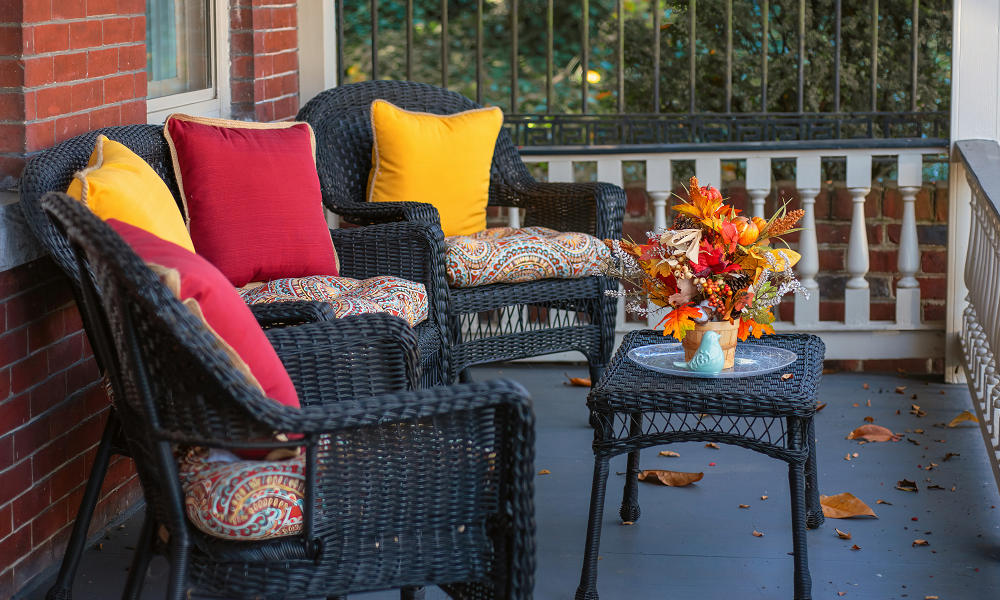Reviews
How to Incorporate Cultural Elements Into Your Outdoor Decor

Creating an outdoor space that reflects your personal style can enhance your home’s overall aesthetic and provide a welcoming environment for family and friends.
Incorporating cultural elements into your outdoor decor not only adds uniqueness but also pays homage to your heritage or appreciation for a particular culture.
In this guide, we’ll explore various ways to seamlessly infuse cultural aspects into your outdoor space.
Understanding your cultural heritage
Before you start decorating, it’s essential to understand the cultural elements you wish to incorporate. Whether it’s your own heritage or a culture you admire, researching symbols, designs, and traditions will help you make informed choices.
- Research cultural symbols and designs: Look into traditional patterns, motifs, and symbols significant to the culture. Understanding their meanings ensures that you use them appropriately and respectfully.
- Consult with cultural experts: If possible, speak with someone knowledgeable about the culture to gain deeper insights and avoid any unintentional misrepresentations.
- Respect cultural sensitivities: Be mindful of cultural appropriation and strive to honor the culture authentically.
Selecting cultural elements for your outdoor space
Once you’ve done your research, you can start selecting specific elements to include in your outdoor decor.
Plants and landscaping
Plants play a significant role in many cultures and can be a living tribute to cultural heritage. Culturally inspired gardens start with the right plants. Platforms like Yard Work can help you find options that match traditional themes and regional styles.
- Native plants: Incorporate plants native to the culture’s region. For example, if you’re inspired by Japanese culture, consider planting cherry blossoms, bamboo, or Japanese maple trees.
- Herbal gardens: Cultivate herbs commonly used in traditional cooking or medicine, such as lavender for a Mediterranean theme or lemongrass for a Southeast Asian garden.
- Garden layouts: Design your garden based on traditional styles, like the geometric patterns of Islamic gardens or the naturalistic approach of English cottage gardens.
Statues and ornaments
Adding statues and ornamental pieces can be a striking way to showcase cultural elements.
- Traditional sculptures: Place statues representing deities, animals, or figures significant in the culture. For instance, a Buddha statue for a Zen garden or terra cotta warriors for a Chinese-inspired space.
- Artisanal crafts: Include handcrafted items like wind chimes, pottery, or mosaics that reflect cultural artistry. These can be sourced from local artisans or authentic cultural markets.
- Wall art: Use murals or wall hangings that depict traditional scenes or patterns.
Water features
Water elements can add tranquility and cultural significance to your outdoor space.
- Fountains and ponds: Install a koi pond for a Japanese-inspired garden, a tiered fountain reminiscent of Mediterranean courtyards, or a reflecting pool common in Persian gardens.
- Water bowls: Use decorative water bowls with floating candles or flowers, common in some South Asian cultures.
- Rain chains: Replace traditional downspouts with decorative rain chains, which are both functional and aesthetically pleasing in Japanese culture.
Pathways and flooring
The materials and patterns used in your outdoor flooring can significantly impact the cultural feel of your space.
- Permeable pavers: Use permeable pavers to create pathways or patios with designs inspired by cultural patterns. Not only do they offer an eco-friendly solution for managing stormwater runoff, but they also come in various styles that can complement your cultural theme. For example, permeable pavers with intricate geometric designs can reflect Islamic art, while natural stone pavers can emulate a European courtyard.
- Mosaic tiles: Consider mosaic tile patterns for pathways or seating areas, which are prominent in Middle Eastern and Mediterranean designs. These tiles can be arranged to create elaborate patterns and images that are both functional and artistic.
- Stepping stones: Use culturally significant symbols or characters engraved on stepping stones to add a personalized touch.
Outdoor structures
Incorporating architectural elements can greatly enhance the cultural authenticity of your outdoor space.
- Pergolas and gazebos: Build structures that reflect traditional architectural styles, such as a Japanese tea house or a Moroccan riad-inspired pergola.
- Arches and gateways: Create entryways with distinctive cultural designs, like a Chinese moon gate or a Roman arch.
Color schemes and textiles
Colors and fabrics can dramatically alter the ambiance of your outdoor area.
- Culturally significant colors: Use colors symbolic in the culture. For instance, red is significant in Chinese culture, symbolizing luck and happiness, while blue and white are prominent in Greek decor.
- Outdoor rugs and cushions: Add textiles with traditional patterns or fabrics, such as Persian rugs, African mud cloth prints, or Indian block prints, to seating areas.
- Canopies and drapes: Use fabrics to create shade and add softness to structures, selecting materials and patterns that align with your cultural theme.
Lighting
Lighting not only serves a practical purpose but also enhances the cultural atmosphere.
- Traditional lanterns: Hang lanterns that are culturally significant, like paper lanterns for an Asian-inspired garden or Moroccan lanterns with intricate metalwork and colored glass.
- Candlelight: Use candles or torches to create a warm, inviting glow reflecting traditional lighting methods, such as tiki torches for a Polynesian theme.
- String lights: Incorporate string lights in patterns or styles that complement your design, like festoon lights in a European café setting.
Using permeable pavers for a cultural touch
Permeable pavers are an excellent way to combine functionality with cultural aesthetics.
What are permeable pavers?
Permeable pavers are paving materials that allow water to pass through them, reducing runoff and promoting groundwater recharge. They are eco-friendly and help prevent erosion and flooding.
Design flexibility
These pavers come in various shapes, sizes, and materials, allowing you to create patterns and layouts that reflect cultural designs.
- Cultural patterns: Arrange permeable pavers in a herringbone pattern common in European streets or in circular designs found in Celtic art.
- Intricate motifs: Use them to create intricate patterns on your patio or walkway, incorporating motifs like mandalas, labyrinths, or traditional geometric patterns significant to the culture you’re honoring.
Eco-friendly benefits
By choosing this type of paver, you’re not only adding a cultural element but also contributing to environmental sustainability, which is valued in many cultures emphasizing harmony with nature.
- Stormwater management: They help manage stormwater naturally, reducing the need for artificial drainage systems.
- Heat reduction: Permeable surfaces can reduce heat accumulation, making your outdoor space cooler and more comfortable.
Material Selection
Select materials that align with your cultural theme.
- Natural stone: For a rustic or traditional look, use natural stone permeable pavers that blend seamlessly with the environment.
- Brick pavers: Ideal for a colonial or European-inspired design, brick pavers add warmth and character.
Bringing it all together
Creating a cohesive design requires careful planning and consideration.
- Balance and harmony: Ensure the cultural elements complement rather than overwhelm your outdoor space. Balance bold pieces with subtle accents to create harmony.
- Personal touches: Incorporate personal items or family heirlooms that have cultural significance to you, adding a layer of personal connection to your decor.
- Functional spaces: Design areas for relaxation, dining, or entertainment enhanced by cultural decor, making your outdoor space both beautiful and usable.
- Consistency: Stick to a consistent theme to avoid a cluttered or disjointed look. Select elements that work well together in terms of color, material, and style.
Final thoughts
Incorporating cultural elements into your outdoor decor is a meaningful way to express your heritage and create a unique space that stands out. From plants and water features to pavers and traditional lighting, there are countless ways to bring cultural significance into your outdoor area. With thoughtful planning and respect for the culture you’re honoring, your outdoor space can become a personal oasis reflecting who you are.
Remember, the goal is to create a space that not only looks beautiful but also resonates with cultural significance and personal meaning. By integrating elements like pavers with cultural patterns, you can craft an outdoor area that is both environmentally friendly and rich in heritage.

-

 World1 week ago
World1 week agoCargo plane plunges into sea at Hong Kong airport; 2 killed
-

 Health1 week ago
Health1 week agoMexico reports new human case of H5 bird flu
-

 US News4 days ago
US News4 days agoUnwarned tornado suspected in Fort Worth as storms cause damage and power outages
-

 World2 days ago
World2 days agoU.S. Navy helicopter and fighter jet crash in South China Sea; all crew rescued
-

 Legal1 week ago
Legal1 week agoMan armed with AR-15 arrested after threats to ‘shoot up’ Atlanta airport
-

 Legal3 days ago
Legal3 days agoMultiple injured in shooting at Lincoln University in Pennsylvania
-

 World1 week ago
World1 week agoMagnitude 5.0 earthquake rattles Dominican Republic
-

 World1 week ago
World1 week agoMagnitude 6.1 earthquake strikes Ecuador–Peru border region




